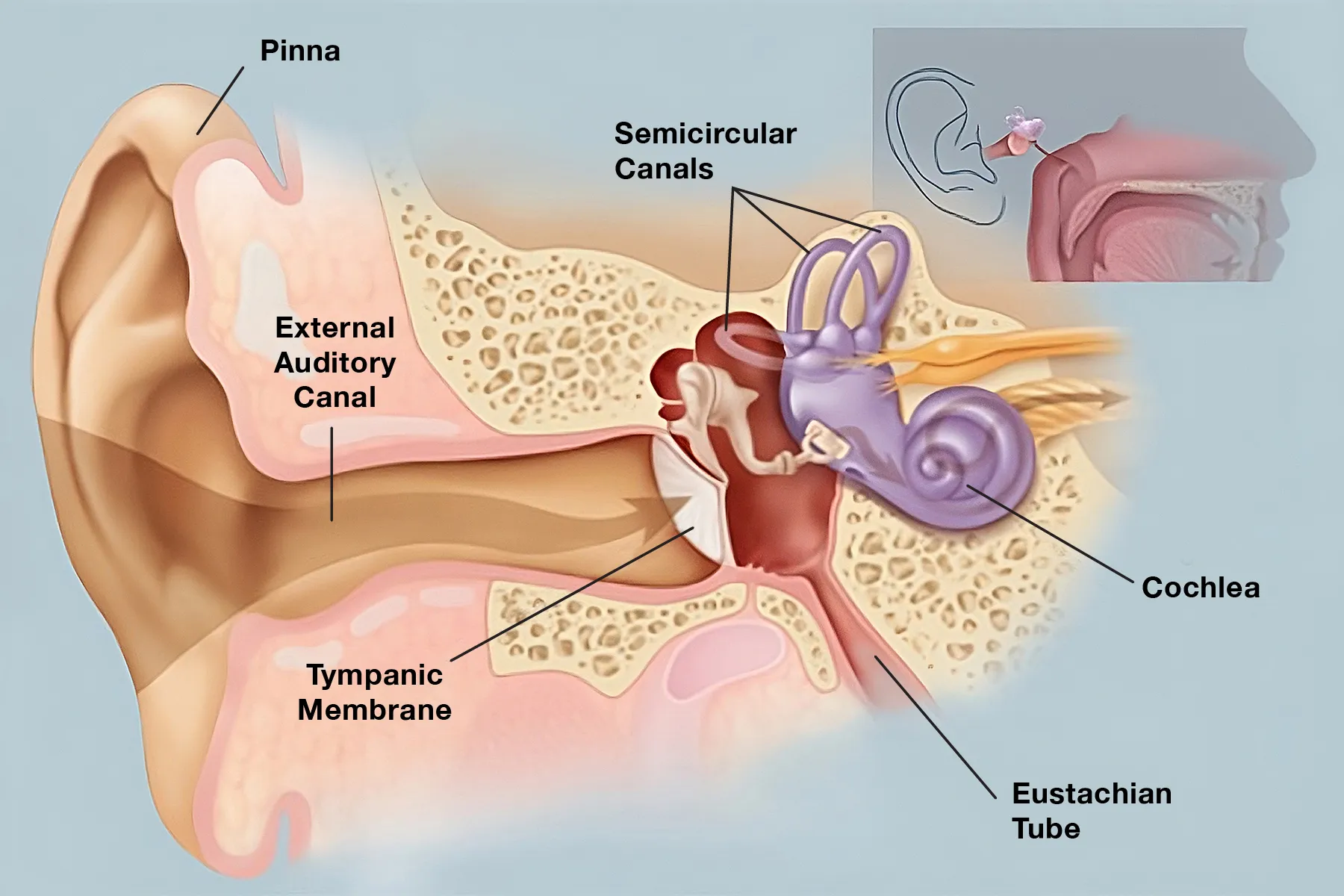The common cold can lead to ear discomfort because of congestion or as a complication of the infection. Both over-the-counter remedies and medical care can help reduce ear pain.
A cold happens when a virus infects your nose and throat, producing symptoms such as a runny nose, cough, and stuffiness. You may also feel mild body aches or a headache.
At times, a cold may also produce pain in or around the ear. This usually manifests as a dull ache and can occur during the illness or after it resolves.
Read on to understand why ear pain can accompany a cold, which remedies can help, and when to consult a doctor.

How a cold can lead to an earache
Ear pain during a cold can arise from several causes.
Congestion
The eustachian tube links the middle ear with the upper throat and the back of the nose. Under normal conditions, it prevents excessive air pressure and fluid from accumulating in the ear.
But when you have a cold, mucus and nasal fluids may collect in the eustachian tube. This can block the tube, producing ear pain and a sense of fullness or “plugged” ears.
In most cases, ear congestion eases as the cold improves. Occasionally, however, it can develop into a secondary infection.
Middle ear infection
An infection of the middle ear, known as infectious otitis media, is a common cold-related complication. It happens when viruses from the nose and throat travel into the ear via the eustachian tube.
Viral irritation leads to fluid accumulation in the middle ear, and bacteria can multiply in that fluid, causing a middle ear infection.
This may cause ear pain along with:
- swelling
- reduced hearing
- green or yellow nasal discharge
- fever
- drainage from the ear
Sinus infection
An unresolved cold can progress to a sinus infection (infectious sinusitis). This causes inflammation in the sinuses, which include spaces in your nose and forehead.
Sinusitis can cause pressure that extends to the ear, producing pain.
Other symptoms may include:
- yellow or green postnasal drainage
- nasal congestion
- blocked breathing through the nose
- facial pressure or pain
- headache
- tooth pain
- cough
- bad breath
- reduced sense of smell
- fatigue
- fever
Home remedies for cold-related ear pain
Most causes of ear pain tied to a cold improve without medical intervention. Still, home treatments can help manage the discomfort.
Warm or cold compress
Applying a warm or cold pack to the affected ear can relieve pain or swelling.
Always wrap the pack in a clean towel to protect your skin from extremes of temperature.
Sleep positioning
If only one ear is affected, lie on the side with the unaffected ear. For instance, if your right ear hurts, sleep on your left side to reduce pressure on the painful ear.
You might also try propping your head on two or more pillows to lower ear pressure, though this can strain the neck, so use caution.
Nasal irrigation
If the earache stems from sinus issues, a nasal rinse can help drain and clear the sinuses.
Stay hydrated
Drink plenty of fluids no matter the cause of your earache. Hydration thins mucus and can speed recovery.
Rest
Take it easy. Rest supports your body’s immune response against the cold or any secondary infection.
Medical options for ear pain from a cold
In addition to home care, a clinician may recommend certain treatments for ear pain.
Over-the-counter pain relievers
OTC pain medications can lower pain and fever.
Ibuprofen or acetaminophen are commonly recommended for an earache.
Follow package directions and consult a clinician about the right dose.
Decongestants
OTC decongestants can lessen swelling in the nasal passages and ears. They may ease symptoms but do not cure an ear or sinus infection.
Decongestants come in different forms, including:
- nose drops
- nasal sprays
- oral tablets or liquids
Follow the instructions on the label, especially when giving these to a child.
Ear drops
OTC ear drops are available to relieve ear pain; use them according to the directions.
If the eardrum is perforated, ear drops could be harmful, so check with a clinician first.
Antibiotics
Antibiotics aren’t usually needed for ear infections or sinusitis. If symptoms are severe, prolonged, or there’s suspicion of a bacterial infection, a clinician may prescribe them.
Precautions when treating earaches from a cold
Cold medications can help with symptoms but might not eliminate ear pain.
Also be careful combining cold medicines with OTC pain relievers, because they can share ingredients and increase risk of overdose.
For instance, NyQuil contains acetaminophen, the same active ingredient in Tylenol. Taking both NyQuil and Tylenol could result in too much acetaminophen, which can harm the liver.
Prescription drugs may also interact with OTC products. If you’re on prescription medications, consult your clinician before using OTC cold or pain medicines.
Also be aware of:
- Cold medicines for young children. Don’t give these medicines to children under two years old unless directed by a clinician.
- Aspirin. Avoid giving aspirin to children and teens because of the risk of Reye’s syndrome.
- Oils. Some people recommend garlic, tea tree, or olive oil for ear infections, but there’s insufficient scientific evidence to confirm their effectiveness; use caution.
- Cotton swabs. Don’t insert cotton swabs or other objects into the ear canal.
When to seek medical care
Ear pain related to a cold often resolves on its own.
However, see a clinician if you experience any of the following signs:
- symptoms that persist for several days
- worsening symptoms
- intense ear pain
- fever
- hearing loss
- changes in hearing
- earache in both ears
- ear discharge
These signs could indicate a more serious issue.
How ear pain is diagnosed
A clinician will use a few approaches to identify the cause of your earache, which may include:
- Medical history. The clinician will ask about your symptoms and any prior episodes of ear pain.
- Physical exam. They’ll examine your ear with an otoscope to look for swelling or pus, and they’ll inspect your nose and throat as well.

If ear pain is chronic, you may be referred to an ear, nose, and throat (ENT) specialist.
Bottom line
Ear pain during or after a cold is common. Most cases are mild and resolve without treatment. Rest, OTC pain relief, and home measures like warm compresses can ease discomfort.
Avoid combining cold medicines and pain relievers without checking ingredients, as interactions or overdosing can cause harm.
Seek medical care if the pain is severe or persistent, or if concerning symptoms develop.


















Leave a Reply
You must be logged in to post a comment.